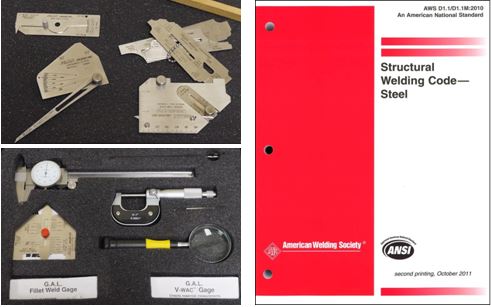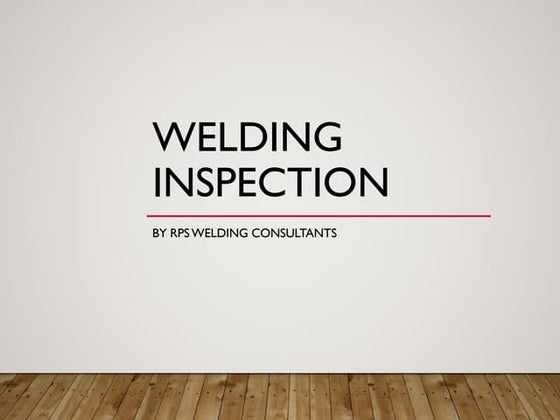How Welding Inspection Gilbert Arizona Can Enhance Your Building and Production Processes
How Welding Inspection Gilbert Arizona Can Enhance Your Building and Production Processes
Blog Article
Checking Out the Value of Welding Examination in Industrial Applications: Securing Versus Failures and Enhancing Longevity
Welding inspection works as a vital line of defense in industrial applications, ensuring the architectural honesty and integrity of bonded elements. By methodically identifying defects such as porosity and incomplete blend, examinations not only avoid failings yet additionally expand the life-span of essential properties. Abiding by market standards boosts both safety and security and operational efficiency; however, the ramifications of ignoring these techniques can be severe. As we check out the diverse advantages of routine assessments, it comes to be noticeable that comprehending these dynamics is not simply a matter of conformity but a calculated imperative for durability and threat mitigation (Welding Inspection Gilbert Arizona).
Role of Welding Assessment
Welding inspection offers as an essential protect in commercial applications, making certain that bonded frameworks satisfy defined standards of top quality and safety and security. This process involves an organized exam of welds to validate their honesty, stamina, and conformity with established codes and specifications. The function of welding evaluation is multifaceted, including both aesthetic evaluations and non-destructive testing approaches, which may include ultrasonic, radiographic, or magnetic particle screening.

In addition, welding examination plays a vital role in regulative compliance. Ultimately, the function of welding evaluation is important in promoting safety, improving performance, and securing financial investments in commercial infrastructure.
Usual Welding Defects

One of one of the most widespread issues is porosity, defined by tiny gas pockets entraped within the weld metal. This occurs as a result of impurities or improper shielding gas, jeopardizing the weld's strength. An additional considerable problem is insufficient fusion, where the weld steel falls short to bond effectively with the base product, potentially resulting in structural weak points.
Fractures can additionally establish during or after the welding procedure, frequently credited to thermal stress and anxieties or inappropriate cooling prices. Furthermore, damaging, where the base metal is deteriorated along the weld grain, can damage the joint and is frequently triggered by excessive warm input or wrong method.
Moreover, lack of infiltration takes place when the weld steel does not reach the root of the joint, causing poor toughness. Understanding these common issues is critical for inspectors and welders alike to guarantee that welded frameworks fulfill security and efficiency requirements, eventually stopping potential failings in commercial applications.
Advantages of Normal Examinations
Routine examinations work as an essential protect in making certain the reliability and durability of welded structures. These evaluations determine prospective problems and weaknesses that may compromise the stability of welds, permitting timely remediation prior to issues intensify. By implementing a structured evaluation regimen, companies can substantially decrease the threat of disastrous failings that may cause costly downtime, equipment substitute, or perhaps mishaps.
In addition, normal assessments contribute to improved quality assurance throughout the welding process. By sticking to a regular examination timetable, companies can make sure that their welding methods meet established top quality standards and ideal techniques. This not only promotes a society of responsibility but also encourages continual enhancement among welding workers.
In addition, routine assessments promote much better maintenance planning. By determining damage early, organizations can purposefully schedule repairs and substitutes, decreasing disruption to operations. This positive technique eventually results in extensive asset life expectancy and improved general productivity.
Last but not least, a dedication to routine examinations can improve a company's credibility in the sector. Stakeholders and customers significantly value companies that focus on safety and security and top quality, therefore enhancing trust and possibly causing boosted business chances.
Market Requirements and Regulations
Complying with sector requirements and policies is a basic aspect of welding assessment that complements the benefits of routine assessments. These standards, established by organizations such as the American Welding Culture (AWS) and the American Culture of Mechanical Designers (ASME), offer a structure for ideal methods in welding processes, products, site link and inspection strategies. Conformity with these laws ensures that welds meet the called for top quality and safety benchmarks, substantially reducing the risk of structural failings.
Governing bodies like the Occupational Safety And Security and Health And Wellness Management (OSHA) further apply standards that secure employees and the setting during welding procedures. By complying with these established standards, markets can improve the integrity of their structures and elements, guaranteeing they do as meant under various functional conditions.
Moreover, adherence to industry requirements promotes consistency in quality control, helping with smoother communication amongst stakeholders and governing firms. This alignment not only reduces responsibility threats yet additionally boosts the integrity of companies in open markets. Inevitably, conformity with welding standards and regulations is not simply a legal responsibility; it is a vital investment in security, performance, and lasting operational success.
Future Trends in Welding Evaluation
As industries remain to progress, the future of welding inspection is poised to integrate sophisticated technologies that improve precision and efficiency. Among one of the most substantial patterns is the fostering of automation and robotics in inspection procedures. Automated systems can perform inspections quickly, reducing human error and boosting throughput in making atmospheres.
Moreover, the combination of expert system (AI) and device understanding formulas will allow predictive analytics, permitting real-time assessments and aggressive maintenance (Welding Inspection Gilbert Arizona). By evaluating data from previous examinations, these innovations can identify patterns that can suggest potential failures, thus prolonging the life expectancy of bonded components

Additionally, the fad towards digitalization will certainly lead to enhanced information management systems that help with far better monitoring, reporting, and conformity with market requirements. In recap, the future of welding inspection This Site is characterized by technological advancements that promise to substantially boost reliability, safety, and operational efficiency in numerous industrial applications.
Final Thought
In final thought, welding assessment offers an essential function in ensuring the integrity and longevity of bonded structures across numerous industrial applications. As advancements in modern technology proceed to develop, the future of welding evaluation assures raised precision and effectiveness, ultimately contributing to the longevity of crucial infrastructures.
Welding inspection offers as a vital line of defense in commercial applications, making certain the architectural integrity and have a peek at this website reliability of bonded elements.Welding assessment offers as a vital safeguard in industrial applications, ensuring that bonded frameworks fulfill specified standards of quality and security - Welding Inspection Gilbert Arizona. Ultimately, the role of welding assessment is important in promoting security, improving performance, and securing investments in industrial infrastructure
These criteria, established by organizations such as the American Welding Culture (AWS) and the American Culture of Mechanical Designers (ASME), provide a structure for best practices in welding procedures, materials, and evaluation techniques.In conclusion, welding inspection serves a vital function in guaranteeing the honesty and sturdiness of welded frameworks throughout various commercial applications.
Report this page